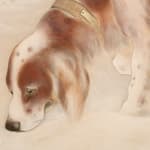Yōkō
Setter in the Snow, 1930s
Two-panel folding screen; ink, mineral colors and shell powder on paper
Size 59½ x 58½ in. (151 x 148.5 cm)
T-4666
Further images
-
(View a larger image of thumbnail 1
)

-
(View a larger image of thumbnail 2
)

-
(View a larger image of thumbnail 3
)

-
(View a larger image of thumbnail 4
)

-
(View a larger image of thumbnail 5
)

-
(View a larger image of thumbnail 6
)

-
(View a larger image of thumbnail 7
)

-
(View a larger image of thumbnail 8
)

-
(View a larger image of thumbnail 9
)

-
(View a larger image of thumbnail 10
)

-
(View a larger image of thumbnail 11
)

-
(View a larger image of thumbnail 12
)

Signed at lower right: Yoko, with a seal A perfectly groomed Irish red and white setter, wearing a leather collar with a metal fitting, intently follows a midwinter scent; in...
Signed at lower right: Yoko, with a seal
A perfectly groomed Irish red and white setter, wearing a leather collar with a metal fitting, intently follows a midwinter scent; in the foreground, fallen snow has half obscured pine saplings and sasa (bamboo grass) and gathered on top of a mossy gate post or mooring post, while leafless trees in the background and a stream, perhaps frozen, to the left emphasize the stillness of the scene. Mineral pigments—deep green, gray green, and red—contrast with thickly applied gofun, a shell-based gesso-like substance widely used in painting of the period and ideally suited to the depiction of deep snow.
Other Japanese paintings of pets (one a German shepherd and the other a cockatoo) offered by Thomsen Gallery in recent years also featured their fashionably dressed young mistresses but in this case the animal is depicted on its own, with the unseen artist playing the role of proud onlooker. One cannot but feel that he or she took some degree of inspiration from animal paintings by British artists of the Victorian era such as Sir Edward Landseer, best known for The Monarch of the Glen (1851), a majestic depiction of a stag in a Scottish landscape. This is clearly not just any red and white setter but the rare and treasured companion of a wealthy owner, its every unique marking carefully observed and skillfully depicted.
Admired for its aristocratic, well proportioned yet powerful appearance, the Irish red and white setter, distinct from the better-known red setter, was rescued from extinction during World War I by the dog breeder Reverend Noble Huston (d. 1944) of Ballynahinch, County Down and later exported to several countries including Spain, England, the United States, and—on the evidence of this painting, Japan as well.
In 1934 the famous statue of Hachiko the faithful Akita hound was erected outside Tokyo’s Shibuya Station where it stands to this day. This perhaps offered artists like Yoko an additional incentive to undertake ambitious, highly finished depictions of their clients’ favorite canines.
A perfectly groomed Irish red and white setter, wearing a leather collar with a metal fitting, intently follows a midwinter scent; in the foreground, fallen snow has half obscured pine saplings and sasa (bamboo grass) and gathered on top of a mossy gate post or mooring post, while leafless trees in the background and a stream, perhaps frozen, to the left emphasize the stillness of the scene. Mineral pigments—deep green, gray green, and red—contrast with thickly applied gofun, a shell-based gesso-like substance widely used in painting of the period and ideally suited to the depiction of deep snow.
Other Japanese paintings of pets (one a German shepherd and the other a cockatoo) offered by Thomsen Gallery in recent years also featured their fashionably dressed young mistresses but in this case the animal is depicted on its own, with the unseen artist playing the role of proud onlooker. One cannot but feel that he or she took some degree of inspiration from animal paintings by British artists of the Victorian era such as Sir Edward Landseer, best known for The Monarch of the Glen (1851), a majestic depiction of a stag in a Scottish landscape. This is clearly not just any red and white setter but the rare and treasured companion of a wealthy owner, its every unique marking carefully observed and skillfully depicted.
Admired for its aristocratic, well proportioned yet powerful appearance, the Irish red and white setter, distinct from the better-known red setter, was rescued from extinction during World War I by the dog breeder Reverend Noble Huston (d. 1944) of Ballynahinch, County Down and later exported to several countries including Spain, England, the United States, and—on the evidence of this painting, Japan as well.
In 1934 the famous statue of Hachiko the faithful Akita hound was erected outside Tokyo’s Shibuya Station where it stands to this day. This perhaps offered artists like Yoko an additional incentive to undertake ambitious, highly finished depictions of their clients’ favorite canines.











